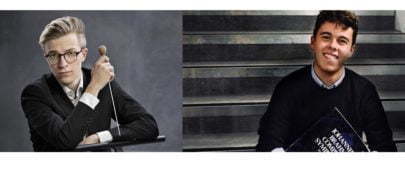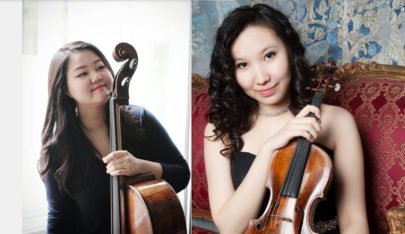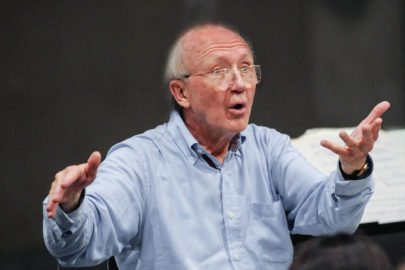Philharmonia Orchestra and Colburn School announce inaugural class of Salonen Fellows
The Philharmonia Orchestra, together with principal conductor and artistic advisor Esa-Pekka Salonen, and Sel Kardan, President and CEO of the Colburn School in Los Angeles, have announced the inaugural class of Salonen Fellows in the Conservatory’s new Negaunee Conducting Program.

British conductor and pianist Angus Webster (right) and Finnish-British conductor Ross Jamie Collins (left) were selected from more than 115 applicants from throughout the world. They will enrol in the Colburn School’s Conservatory of Music and join the Colburn Artists roster, beginning with the 2019-2020 academic year. The opportunity to identify and work with outstanding young conductors will be part of the Philharmonia’s Emerging Artists programme. Known as Salonen Fellows, they will gain significant real-world podium experience through work with the Philharmonia in the UK and abroad, as well as in LA.
Violin and cello winners at Vienna Classic Strings competition
The Classic Strings Festival and International Competition returned for its second edition, this year taking place in Vienna, following from its inaugural event in Riga last year.
Meruert Karmenova (pictured right) and Grace Sohn (pictured left) take first prizes over the weekend, joining viola winner Luosha Fang.

The competition element took in violin, viola and cello categories, each with a €20,000 top prize and the violin and cello finals took place over the weekend.
The competition is unusual for accepting previous winners as contestants, and Karmenova also won last year’s event.
Heinz Holliger in sieben Facetten
Zu Beginn galt die Aufmerksamkeit einem phantastischen jungen Oboisten, der mit seiner Musikalität und Virtuosität rasch berühmt wurde. Der Arztsohn, geboren am 21. Mai 1939 in Langenthal, wuchs in einer künstlerisch angeregten Atmosphäre auf. Der etwas ältere, 2010 verstorbene Bruder Erich wurde Theaterregisseur. Der Gymnasiast sog früh vieles in sich auf, was ihn später noch prägen sollte: Musik, Literatur, etwa die Lyrik von Georg Trakl: „Im Gymnasium bin ich zum ersten Mal mit dem Horror des Ersten Weltkriegs konfrontiert worden, obwohl man das im schweizerischen Geschichtsunterricht lieber vertuschen wollte. Man sprach eher von den Bauernkriegen. Trakl zerbrach am Krieg, weil er als Sanitäter allein über hundert Schwerverletzte, die nur noch geschrieen haben, pflegen musste. Damals schon war ich ein totaler Trakl-Fanatiker, was allerdings vielen Gymnasiasten passiert. Schon mit neunzehn begann ich, zu Trakl Skizzen zu machen.“
Als Schüler von Émile Cassagnaud in Bern wurde Holliger in der französischen Oboentradition ausgebildet. Aber er blies nicht nur wunderschön, sondern er zog auch (mittels Zirkuläratmung) waghalsig weite Melodiebögen, etwa in Bach-Konzerten. Später unterrichtete er jahrelang an der Musikhochschule in Freiburg. Und er hätte sich mit der Solooboisten-Stelle bei der Basler Orchester-Gesellschaft auch schon auf sein Altenteil besinnen können, aber die Soloauftritte und Aufnahmen häuften sich. Und so verließ er das Orchester 1963 wieder.

At the beginning, attention was directed to a fantastic young oboist who quickly became famous for his musicality and virtuosity. The doctor’s son, born on May 21, 1939 in Langenthal, grew up in an artistically stimulated atmosphere. As a high school student he absorbed a great deal of what was to characterise him later: music, literature, such as the poetry of Georg Trakl: “In high school I was confronted for the first time with the horror of the First World War, even though the Swiss history lessons would rather cover it up. One spoke of the peasant wars. Trakl’s soul was ripped to shreds in the war, because as a paramedic he alone had to care for over a hundred severely injured people who only cried. At that time I was a total Trakl fanatic, which happens to however many high school students. Already at the age of nineteen I started sketching Trakl.”
As a student of Émile Cassagnaud in Bern, Holliger was trained in the French oboe tradition. He did not only play beautifully, but he also (by means of circular breathing) dared to pull wide melodies, for example in Bach concerts. Later he taught for years at the Musikhochschule in Freiburg. And with the solo oboist position at the Basler Orchester-Gesellschaft, he could have already remembered his own part, but the solo performances and recordings became more frequent. And so he left the orchestra again in 1963…
 BACK
BACK